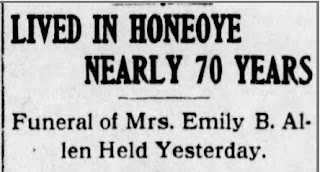In the May 1880 issue of Zion’s Watch Tower, the
list of contributors had a new name, L A Allen. This was Lizzie (Elizabeth) A
Allen, and her history is reviewed in Separate
Identity volume one, pp. 203-207.
She and her father, Ira, who died in 1881, had been
supporters of Nelson Barbour, but when the division occurred she supported CTR.
Eventually, she left Zion’s Watch Tower
to support John H Paton’s Universalist group and write for his paper The World’s Hope. In 1890 she was the
pastor of his Church of the Larger Hope in Buchanan. In the 1890s she wrote for
a Universalist paper Manford’s New
Monthly Magazine. This dwindled in the latter half of the 1890s and may
have coincided with her marriage (see below), or it just may be that she
switched to writing for other publications that are yet to be discovered.
The last sighting of her had been in 1907 in the
report of her mother’s funeral. We will pick up the story from there.
When Emily Allen died there was a report in the Rochester Democratic and Chronicle for 20
February 1907 which mentioned her surviving family. Lizzie was mentioned as now
living in Chicago. Crucially for research, the report also mentioned that one
of Lizzie’s sisters was now a Mrs Jessie Henby who resided not far from
Chicago.
It appears that Lizzie was to die by drowning the
following year in June 1908.
Below is the death certificate for an Elizabeth A
Allen, aged 49, who died from drowning on 24 June 1908.
There are quite a number of people named Lizzie
Allen in the records to make life difficult, but her parents are listed here as
Ira and Emily, which makes this the right person. Lizzie has been married but
is using her maiden name, and in fact, we do not know for sure who her husband
was. She has one living child. Her
occupation is housekeeper, and that was her temporary employment when visiting
Muskegon, Michigan. According to the certificate she died from accidental
drowning in Black Lake while bathing, and there was no inquest.
Armed with the certificate it was possible to trace
newspaper accounts of what happened. There are two newspaper accounts. In the
first she is a woman of mystery – because she was there temporarily on a kind
of extended vacation, but no-one really knew who she was. From The Muskegon Chronicle for 25 June 1908:
The accident was described thus: “The woman had
stepped into a pit in the sandy beach of the lake where the water was about 10
feet deep and apparently did not know the first thing about swimming or the
science of keeping afloat.”
Lizzie presented the paper with several mysteries:
So she had been married about ten years before
(around the time her known writings dried up) but the marriage had only lasted
about three months, and left her with a young son named Roger who was nine
years old. She had continued using her maiden name, and the newspapers do not
give her married name. She was known to be an expert in stenography and typing
– that was part of the mystery – why was she doing domestic work? She had
brought her typewriter with her which suggests active writing. Amongst her
possessions were some letters from a mysterious “H.” That mystery remains
unsolved.
In the second cutting, after they had been in touch
with her family, they now knew a little more. From The Muskegon Chronicle for 27 June 1908:
She is now described as a writer and editor. She was
a member of a Chicago social settlement. The settlement movement was an
important reform institution in the late nineteenth and early twentieth century
providing services and trying to remedy poverty in crowded immigrant
neighborhoods of industrial cities. The best known settlement in the United
States at the time was Hull House in Chicago. According to one reference work
unrelated middle-class men and women often lived co-operatively as “settlers”
with the aim of sharing knowledge and culture and implementing “social
Christianity.”
The full report shows that her family who had now
been contacted included a Mrs A E Henby, which tallies with Lizzie’s named
sister at her mother’s funeral the previous year. Jessie Allen (1871-1952) had
married Arthur Elias Henby (1874-1936) who became a homeopathic doctor.
The accident was viewed as straightforward – while
paddling in the lake she fell into a hidden hole and drowned – while her young
son, Roger, was nearby. He called for help, but it was too late. Since Lizzie had a history of guilt and
self-loathing that pushed her towards Universalism (see Separate Identity Volume 1, pp. 206-207) the possibility of suicide
while mentally disturbed comes to mind. However, the locals without that
background judged this to be a simple tragic accident and no inquest was required.
Her body was taken by her sister back to Chicago and there was cremated.
It was a sad end, and there may be more of her
activities from the late 1890s to still discover.







